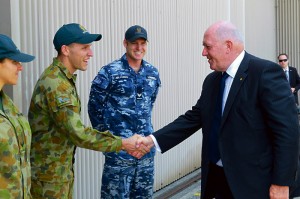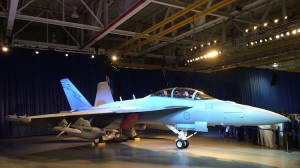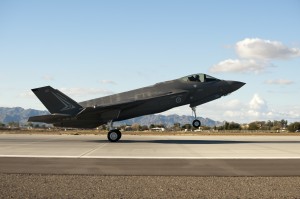2015-09-22 By Robbin Laird
In this interview, the discussion continues with Group Captain Robert Denney, Chief of Staff, for the Air Combat Group.
In an interview conducted at Williamtown Air base on August 12, 2015, Denney discussed the challenges of current operations and working the transition whereby Super Hornets have come into operation, and the ACG is preparing for Growlers next year, and F-35s thereafter.
Group Captain Denney has an F-111 background, and then was involved in the Super Hornet transition, became a Super Hornet squadron commander (6th Squadron), was involved in the CAOC during Operation Okra in the last part of 2014, and now has assumed his current position at Williamtown.

Both Roberton and Denney have recent combat experience associated with Operation Okra and the ACG is supporting and force generating for the continued Middle East operations as well as other current demands. This means that meeting the current operational needs is the priority but at the same time, the ACG is involved in the transition whereby Growlers and then F-35s are coming to Williamtown and Amberley air bases.
“A major challenge we are facing is managing the double transition, the first with the Growlers in 2017 and thereafter the F-35s.
We already have folks training at Luke AFB and our initial F-35s are there.
But they will be based at Williamtown.”
Question: How do you see the impact of the Growler on the ADF?
Group Captain Denney: Many are looking at this as just another new airplane.
But when the force starts using it they will grasp quickly what this electronic warfare asset can bring to the joint operational combat space.
And once that happens, the appetite for this kind of capability will grow.
Question: You have only fairly recently introduced the Super Hornets, you have modernized your Hornets, are adding the Growler and the F-35 is coming to the force, how does that affect your thinking about the way ahead?
Group Captain Denney: With the compressed introduction of combat capabilities, this allows us to expand our thinking about how to use the various platforms in a diversity of ways.
The rules are, there are no rules.
We get to make the rules over the next five years,
We can shape how we will employ these platforms and we do not have to be constrained by how we used them in the past, because there is no past literally speaking.
When we first did the F-111 to Super Hornet transition we tried to hold on to some F-111 isms but then as we got smart we kept the relevant ones and threw the rest of those isms away. Having done that, we understand that a transition is not about replicating past approaches and concepts of operations. It is about shaping new ones.

When we got the Super Hornet we understood the goal was not simply to make it an above average Hornet, but really a very different asset.
We understand with the coming of the F-35 it is not even in the Hornet family and we will work how to leverage it to rework the entire strike force.
We have adjusted our entire fighter tactics to what the Super Hornet has brought to the force rather than simply extending our previous Hornet tactics.
We expect the same with the coming of the F-35.
It’s normal to be different.
Question: You have modernized the Hornet and have leveraged the Super Hornet to change tactic. How would you describe that process?
Group Captain Denney: We have focused not just on optimizing what the Super Hornet can do but how it improves the capability of the classic Hornet.
How do we integrate a package of classic hornets with Super Hornets to create a more significant effect in the battlespace?
How can we augment what Hornets can do?
How can we leverage what Super Hornets can do and be reconfigured to do to expand the effects in the battlespace?
We are already developing a leapfrog approach to the introduction of new platforms, and this is preparing us to think about the coming of the F-35.

How do we leverage the F-35 to get greater effect from the Super Hornets and Growlers?
How do we use our air warfare packages with out naval assets such as the Air Warfare destroyer to get better effects in the battlespace?
It is not just about your platform; it’s about the capability you can bring to bear in that joint and coalition arena.
Question: Australia faces a large air and space extended area for defense. How does this impact on the evolution you are describing?
Group Captain Denney: In a way, there is a moat surrounding Australia, but to defend the area and to work with allies requires extended reach.
What we can do, if we do a good job integrating capabilities, is to shape an air-ground-naval force with reach and capability to shape the kind of effects we need to have in the extended defense area surrounding Australia.
And new platforms coming into service, such as the LHD, can provide an important impetus to shaping how we will support from an integrated air-sea-ground space point of view.
Question: Australia has done significant modernization of its classic Hornet force.
What unique modernizations has the RAAF done?
Group Captain Denney: The basic modernization path has been from a classic fighter platform to one able to be integrated into the IT combat space and to deliver precision weapons on moving targets; and to do so when informed by other air and ground assets of where the targets are and when to hit them.
That is a big change over the 30-year life of the classic Hornet. Over the past 15 years we have moved the classic hornet into the network-centric pilot warfare world.
There are unique Hornet adaptations, such as using ASRAAM, and adopting onto it kit we had on the F-111s such as the ALE-47, which provides for self-protection.
We have adopted US Navy modifications as well as our own to evolve our classic Hornets.
And integrated with the new helmet and sighting system we can fire ASRAMM over the shoulder. With today’s systems, you can kill the adversary from where he is not expecting it; it is not a dogfight world anymore.
Question: So for you Plan Jericho underscores the legitimacy of how you see the transition challenge and reinforces the legitimacy of rewriting the rules of concepts of operations with the new capabilities coming into the force?
Group Captain Denney: That is a good way to look at it.
What Jericho provides for is that opportunity to rewrite the rules.
It really is a great opportunity to push the boundaries that we previously had on ourselves and to start thinking about better ways to operate across platforms, and to break out of the single stove piped platform-centric type of thinking.
We are only just starting the journey.
Plan Jericho Report:
A comprehensive report on the Williams Foundation 6 August seminar, Plan Jericho, Shaping Design-Led Innovation, has been prepared for the Foundation by Dr Robbin Laird.
Dr Laird has been reporting on the RAAF’s Jericho journey since the first Williams ‘5th Gen’ seminar in March 2014, and has been an active and supportive participant in the Williams seminars over the last 18 months.
Dr Laird’s report explores and analyses the themes and issues discussed at the seminar on 6 August as well as presenting an excellent summary of each of the presentations. He has used an episode from the Battle for Britain as a means of ‘setting the scene’ and highlighting the centrality of a concept of operations to provide the framework and foundation for integrating across platforms and enablers.
Dr Laird postulates that without such a conops to support the future 5th generation enabled ADF, our warfighting effectiveness will be sub-optimal.
Dr Laird also conducted a series of interviews with the RAAF’s senior leadership to inform his analysis of the RAAF’s transformation challenges and opportunities.
Interviews with CAF and DCAF, operational and FEG commanders, and the outgoing CAF give this report a unique perspective.
Current operations are reviewed, future challenges embraced, and the Jericho implications for the joint battlespace and Defence Industry are candidly discussed.
http://www.williamsfoundation.org.au/Resources/Documents/LairdPlanJerichoReportSep2015.pdf

